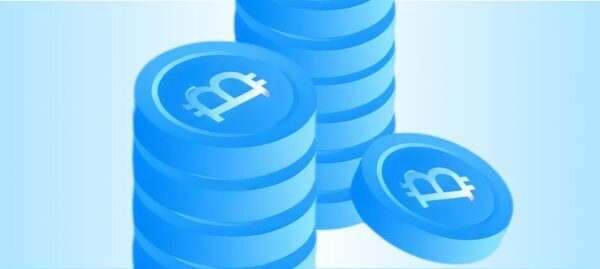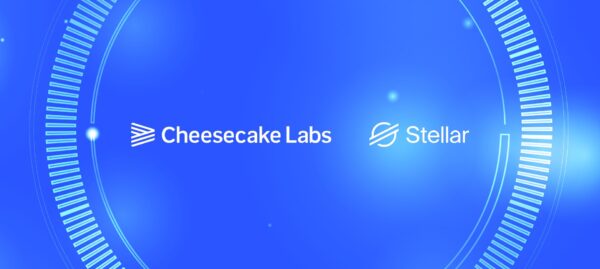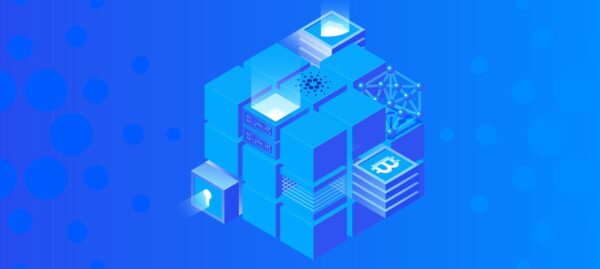What Are Stablecoins, and Why Should You Know About Them?
Gabriel Soares | Nov 26, 2025
A new global financial messaging standard, ISO 20022, was developed to enhance data exchange and communication between financial institutions. Over the past few years, we’ve already seen financial institutions adopt this new standard. Now all financial organizations need to start adopting ISO 20022 in 2023 and must be fully compliant by 2025.
Why is ISO 20022 so important? By offering a single, unified language for electronic payments, securities trading, and other financial transactions, ISO 20022 seeks to increase efficiency, decrease costs, and increase transparency throughout the financial ecosystem.
Here we’ll take a look at what ISO 20022 is, what it means for the finance industry, and how it will be implemented worldwide. Let’s dive in!
The ISO 20022 migration represents the largest-ever shift to a single messaging standard. Any new payment schemes that will be introduced anywhere around the world will use the ISO 20022 message standard, gradually aligning all international payment services.
By standardizing messaging for domestic and cross-border payments and cash reporting across the financial industry, ISO 20022 aims to enable interoperability between financial institutions, market infrastructures, and customers. The standard covers messages through the end-to-end payments chain from customer to bank, bank to bank, and cash reporting.
Using well-structured messages to unify the many existing standards will improve the customer experience by reducing manual tasks, increasing accuracy and compliance, and improving resistance to fraudulent activities.
The ISO 20022 timeline is different around the world. And because the COVID-19 pandemic disrupted operations at financial institutions, they were given more time to complete the migration. In the US, this is the timeline:
SWIFT implemented the adoption of ISO 20022 messages for cross-border payments and reporting (CBPR) in March of this year. The coexistence period for the MT legacy non-XML proprietary messaging format alongside the XML-based MX replacement will be almost three years, during which some financial institutions will begin sending ISO 20022-compliant messages. Swift will also enable the interoperability of MX and MT with its central In-flow Translation service.
Financial institutions can migrate at their own pace using central In-flow translation or local translation services until their back office is natively ready to process messages in the new format.
Any bank can start sending MX messages independently from March 2023, regardless of their correspondent’s preferred channel. The SWIFT ISO 20022 migration for cross-border payments and cash management messaging must be completed by November 2025.
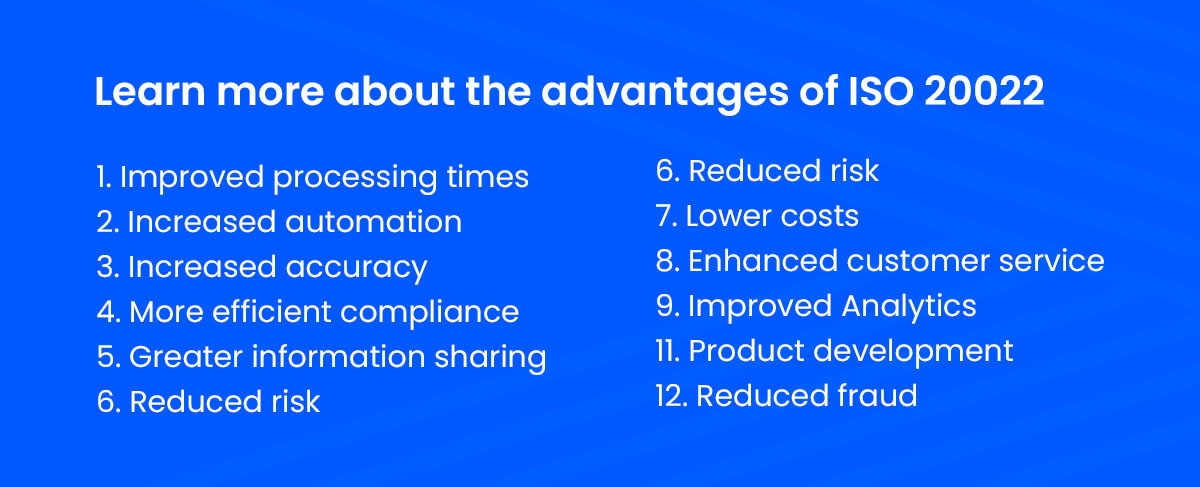
There are several important benefits to the industry from migrating to the new standard:
The new structured data fields are designed to hold information according to specific rules, like payment purpose, type, and fees. This allows bank systems to identify transaction data faster for more efficient wire transfers and real-time payment processing, reducing settlement times.
Providing a more structured way of exchanging information will facilitate increased automation, reducing the need for manual input to help limit human error.
The improved data granularity enabled by the new structured fields can improve the accuracy of the payment process for a more reliable settlement. Banks will have access to clear information about the full payment lifecycle, enabling greater accuracy in financial crime checks.
Screening systems to ensure financial institutions comply with sanctions currently have to scan each field in a message to identify the payment’s country information and check it against sanction rules. With ISO 20022, they can check against the “Country” field, accelerating the process.
The standard can also help institutions comply with other regulations by providing comprehensive data for reporting, reducing the cost of compliance, and enhancing regulatory oversight.
Current payment systems are programmed to accept limited data from existing message formats. Because ISO 20022 supports more detailed information collection, financial institutions have more information to share for things like financial crime detection.
While it can be tempting for institutions to truncate the message fields to limit the changes they need to make to their systems, this could result in the loss of crucial data.
Banks and other financial institutions often have multiple legacy systems that use different formats, particularly in cross-border systems, which raises the risk of errors creeping into transactions. The shift to a single standard allows them to unify their internal formatting and reduce risk.
Managing multiple legacy systems can be costly, so standardizing systems can help to cut maintenance and oversight costs. Banks can also improve their identification and management of fraud, credit, and operational risks, making mitigating financial losses easier.
The ability to offer faster, more convenient, and more secure payment options will improve the customer experience, increasing satisfaction, loyalty, and engagement.
Financial institutions will have access to detailed data about each payment, giving them enhanced visibility into payment flows to improve forecasting. They will have access to more sophisticated analytics to determine trends across different sectors or regions and identify new opportunities to increase revenue streams.
Banks can use transaction data on senders, receivers, and payment types to create new targeted and personalized products and services based on customer behavior, like financial advice based on payment history.
ISO 20022 messages contain five data points, categorized as enhanced fraud data (EFD) that can be analyzed to identify potentially fraudulent transactions: “Purpose Code,” “Age of Account Holder,” “Tenure of Account,” “Turnover of Account,” and “Type of Account.” The industry is exploring ways to use the information collected in these fields to potentially reduce payment scams.
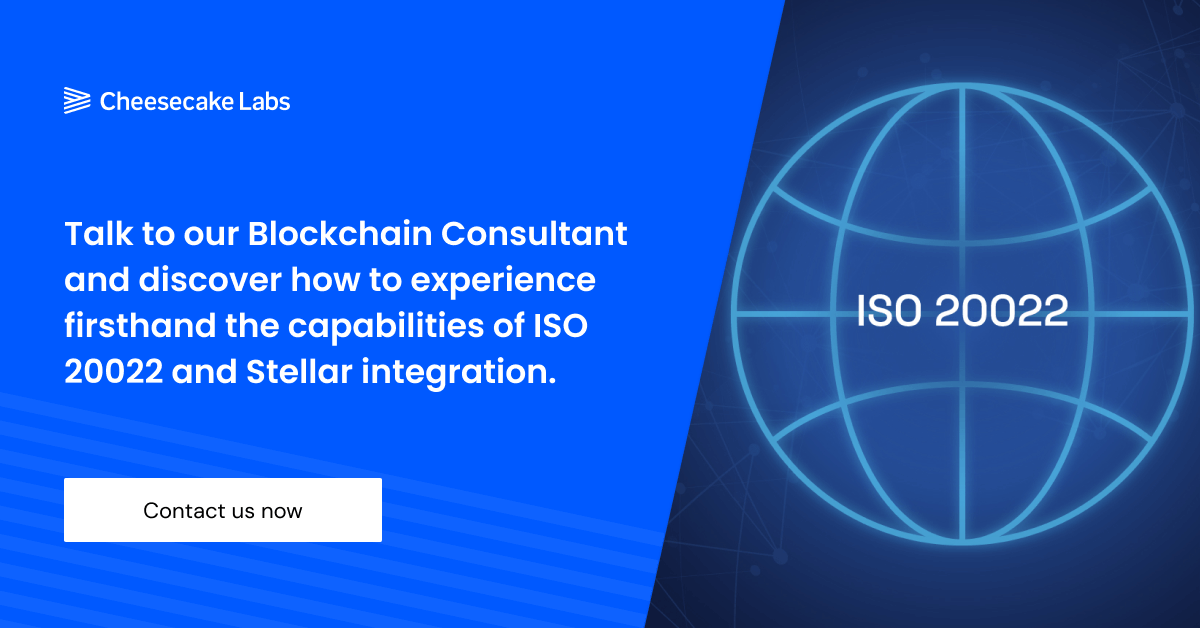
The global migration to ISO 20022 will create a common language for payment information that will replace legacy domestic standards in more than 70 countries around the world. It has already been adopted in several countries, including Switzerland, China, India, and Japan.
By bringing together more than 200 payment types, ISO 20022 will standardize financial transaction data and make payment systems interoperable across borders, harmonizing formats and components from different payment methods that were previously not compatible.
Within five years of adoption, the standard is expected to be used in around 80% of high-value payments by volume and 90% by value.
The transition is being facilitated by some of the world’s largest payment infrastructure providers, including the Bank of England’s CHAPS system, Target2, and SWIFT.
A major change facilitating global implementation is the ability to accommodate longer references for non-Latin alphabets, featuring a character set that is ten times larger than that of MT messages, allowing for greater storage and transmission of data. This functionality is significant for countries like China, an early adopter of the standard.
The worldwide adoption of standardized financial messaging will significantly impact financial institutions, corporations, and businesses in the financial services industry.
SWIFT’s global messaging network makes it easy for banks and other financial institutions to securely exchange information and carry out international transactions. It’s a truly massive network, recording 44.8 million FIN messages daily in 2022.
That’s why SWIFT’s adoption of ISO 20022 is a significant step toward a more streamlined and uniform financial environment. Financial institutions can gain from quicker transaction processing, better data quality, and increased interoperability by combining the strength of SWIFT’s extensive network with the standardized messaging format of ISO 20022.
Some legacy systems will be unable to process or support messaging in the ISO 20022 format. Outdated systems need to be updated or replaced, and financial institutions must allocate resources to make the transition.
Payment providers will need to fully understand the changes to transaction messaging and shift their systems to accommodate the standard, including the rules for anti-money laundering (AML), fraud, and compliance checks.
ISO 20022 is not the only technology transformation or regulatory requirement that banks are dealing with, which can result in them making minimal changes that can be inadequate over the long term.
All payment formats will adopt the ISO 20022 standard, but there are important differences in how it will be introduced for different payment schemes, such as High-Value Payment System Plus (HVPS+) and CBPR+.
The processing of cross-border payments through SWIFT relies on the alignment of its messaging system with HVPS. The changes also present opportunities to align domestic payment systems, enabling long-term resilience.
With different countries setting various deadlines to adopt the standard at different times, international institutions need to have detailed strategies to manage their ISO 20022 implementation.
The screening, monitoring, and analysis of payments must be adjusted to process ISO 20022 transactions while managing the transition on different timescales in different countries.
ISO 20022 messages contain far more data than older standards, which requires new infrastructure to manage the larger volumes of data.
Financial institutions will need to establish coordinated teams to streamline the expansion of their data management capabilities and ensure best practices are implemented across different departments.
Banks will need to introduce changes to many of their daily processes while minimizing the impact on their operations or customer service experience. Institutions should carry out extensive testing to avoid any serious issues.
The extensive impact of ISO 20022 implementation requires education and training at each transition stage. This important process must be managed properly to ensure that it doesn’t put too much pressure on the teams involved.
ISO 20022 Implementation: Timeline
There is no single ISO 20022 date for adoption. Some countries, industries, and financial institutions have already made the transition, while others are still in the planning stage.
The following countries have set deadlines:
The banking industry has scheduled the transition for cross-border payments between 2022 and 2025 because some countries in Asia have already made the shift. The schedule for domestic payments varies by market. Some countries will complete the migration by 2023, while others will take longer.
In the securities industry, the ISO 20022 start day varies by asset class and market, with some making the transition in 2023.
The timescale for the cryptocurrency industry is not yet defined and will be based on regulations and market demand. Some cryptocurrencies and exchanges have already implemented the standard to support the interoperability of blockchain payment systems with traditional financial systems. However, as ISO 20022 is expected to be adopted across the financial industry by 2025, cryptocurrencies will likely join the migration.
ISO 20022 crypto projects could be well placed to gain a first-mover advantage if they go live earlier. The rising adoption of stablecoins like USDT and USDC for cross-border payments and remittances in various countries indicates the need for integration between cryptocurrencies and financial institutions using ISO 200022.
As one of only two default blockchain solutions members of the ISO 20022 Standards Body, Stellar and its native digital currency, XLM, offers unique advantages for financial institutions looking to leverage the new messaging standard.
By partnering with Stellar, organizations can capitalize on the network’s speed, low-cost transactions, and compliance features while benefiting from the improved communication and data exchange facilitated by ISO 20022.
Financial institutions can use the Stellar network and ISO 20022 messaging standard to offer faster, more cost-effective cross-border payment solutions.
By streamlining communication and transaction processing, organizations can reduce the time and resources needed to send funds across borders, resulting in a better customer experience and increased operational efficiency.
Stellar’s low transaction fees and rapid processing times make it an ideal solution for remittance services. By integrating with ISO 20022, financial institutions can further enhance their remittance offerings by ensuring seamless communication with other market participants and reducing potential errors or delays.
By leveraging the Stellar network and ISO 20022, financial institutions can improve the efficiency and transparency of securities settlement processes. The standardized messaging format enables more accurate and timely reporting, while Stellar’s rapid transaction processing ensures faster settlement times and reduced counterparty risk.
The combination of Stellar’s blockchain technology and ISO 20022 can enhance trade finance processes by providing a secure, transparent, and efficient platform for data exchange and transaction processing.
This can help financial institutions reduce the time and resources required to manage complex trade finance operations, passing those benefits on to their clients.
By adopting the ISO 20022 messaging standard, financial institutions can improve the quality and consistency of their regulatory reporting. This, combined with Stellar’s secure and transparent blockchain infrastructure, can help organizations meet evolving regulatory requirements and reduce the risk of non-compliance.
The adoption of ISO 20022 and the integration of Stellar’s blockchain technology are critical for financial institutions seeking to remain competitive in today’s rapidly evolving financial landscape.
By embracing these innovations, organizations can streamline operations, reduce costs, and improve customer experiences, positioning themselves for success in the global financial market.
At Cheesecake Labs, we pride ourselves on staying ahead of the curve in the rapidly evolving world of finance. Our commitment to ISO 20022 compliance and our position as the preferred Stellar integration partner ensures that our solutions are up-to-date with the latest standards and tailored to your unique needs.
Whether you’re a financial institution, a startup, or an enterprise, our team of experts is here to help you navigate the complexities of ISO 20022 and Stellar integration.
Ready to explore how ISO 20022 and Stellar integration can transform your financial operations? Contact us today and let Cheesecake Labs be your trusted partner on this exciting journey.

ISO 20022 is an open standard for banks and other financial institutions exchanging electronic messages that provide structured, rich data for payment instructions. The aim is to standardize and modernize the international payments industry.
SWIFT is a payment network that uses MT messaging, while other networks use different types of messaging. ISO 20022 will standardize the messages that financial institutions send each other for cross-border payments. SWIFT will transition to the MX format to comply with the standard.
Financial institutions need to start the migration to ISO 20022 in 2023 and must be fully compliant by 2025.
One way to invest to profit from the migration is to buy ISO 20022 coins, which are cryptocurrencies that comply with the standard. ISO 20022 tokens provide enhanced functionality including efficient and secure messaging, improved data analytics, and interoperability between systems, which could drive adoption and increase demand.
The ISO 20022 crypto list currently includes seven tokens:
Stellar (XLM)
Algorand (ALGO)
Hedera (HBAR)
IOTA (MIOTA)
Quant (QNT)
Ripple (XRP)
XDC Network (XDC)

Douglas started as a Senior FullStack Developer at Cheesecake Labs and currently he's Partner and CBDO at the company.
